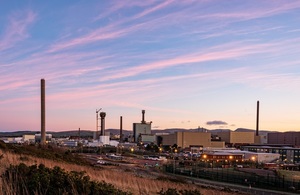Sellafield Ltd to restart reprocessing and further boost operations in 2020
A 6-month operational plan has been mapped out to restart vital hazard and risk reduction work at Sellafield.

image of the sellafield site at sunrise
An operational plan which safeguards jobs in the nuclear supply chain and restarts vital hazard and risk reduction work including Magnox reprocessing at Sellafield has been mapped out for the next 6 months
So far there has been a cautious, managed restart of work on the Sellafield site which has already seen the number of people safely working on the Sellafield site double from 1,000 in the immediate aftermath of the COVID-19 lockdown to circa 2,000 now.
A new 6-month tactical plan has now been agreed which increases the number working on site to an expected 4,000 by September, then peaking at around 4,500 later in the 2020 calendar year.
Risk assessments analysing how work can be safely carried out within the necessary COVID-19 protective measures mean that thousands of people have already moved off site to work remotely (pre-COVID there would typically be circa 8,000 people on the Sellafield site on a typical working day).
Crucially, the new plan provides similar levels of work for contractors as before the crisis (the plan estimates 2,400 people from the supply chain will be on site per day, compared with 2,700 contractors pre-COVID). This will be vital for safeguarding specialist nuclear skills built up over many years and protecting the local economy.
Key work areas planned to ramp up include:
- Restarting the ‘last lap’ of the Magnox reprocessing plant to begin reducing the final 1% (538 tonnes) of fuel left since reprocessing began in 1964. This will involve reopening supporting plants, laboratories and our site railway network.
- Restarting the commissioning and building of the waste retrievals machines set to get the waste out of our highest hazard legacy storage building, the Magnox Swarf Storage Silo.
- Starting to remove nuclear waste and sludge again from our legacy ponds.
- Resuming demolition work to remove the seismic risk from the most prominent structure in our skyline - the Windscale Pile Chimney.
- Further increasing construction work on the new facilities needed to deliver our clean-up mission.
- Cleaning out the now-retired Thorp reprocessing plant.
- Ramping up waste handling and characterisation work as the operational throughput increases.
- Demolishing old buildings and clearing land ready for new decommissioning facilities.
- Ramping up our work in processing, storing and repackaging Special Nuclear Materials.
- Restarting more of the engineering and maintenance work which was paused 3 months ago.
The confidence to accelerate the operational recovery has been built up through Sellafield Ltd’s progressive ‘lead and learn’ approach in carrying out work safely in the new COVID-19 environment.
Thorough risk assessments have been carried out, in line with guidance from the government and Public Health England.
The plan also allows for work to be paused or ramped back down if circumstances change, to protect employees and safeguard the core job of maintaining the safety and security of a nuclear site.
Chief Operating Officer Rebecca Weston said:
In this plan we have to think flexibly and be prepared for things to change again. But right now, we have analysed what work we expect to be able to safely carry out over the next 6 months and this is our ambition.
We are still keeping close controls on who can return to work in order to keep people safe. Thousands of people working for Sellafield Ltd and our supply chain will continue to work remotely where it is feasible for them to do so.
Restarting Magnox reprocessing and ramping up other hazard and risk reduction work will be a huge step forward in our recovery plan and returning to the ‘new normal’.
Maintaining a safe and secure site is a nationally important mission everyone is behind and I’d like to thank each and every person who is continuing to work through the crisis and looking out for others.